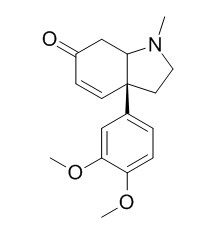Mesembrenone
Mesembrenone, sucrose and obtusalin, the extracts of Sceletium tortuosum show antimalarial activity with activity values ranging between 1.47 ug/ml and 7.32 ug/ml, well below the 10 ug/ml cut off value.
Inquire / Order:
manager@chemfaces.com
Technical Inquiries:
service@chemfaces.com
Tel:
+86-27-84237783
Fax:
+86-27-84254680
Address:
1 Building, No. 83, CheCheng Rd., Wuhan Economic and Technological Development Zone, Wuhan, Hubei 430056, PRC
Providing storage is as stated on the product vial and the vial is kept tightly sealed, the product can be stored for up to
24 months(2-8C).
Wherever possible, you should prepare and use solutions on the same day. However, if you need to make up stock solutions in advance, we recommend that you store the solution as aliquots in tightly sealed vials at -20C. Generally, these will be useable for up to two weeks. Before use, and prior to opening the vial we recommend that you allow your product to equilibrate to room temperature for at least 1 hour.
Need more advice on solubility, usage and handling? Please email to: service@chemfaces.com
The packaging of the product may have turned upside down during transportation, resulting in the natural compounds adhering to the neck or cap of the vial. take the vial out of its packaging and gently shake to let the compounds fall to the bottom of the vial. for liquid products, centrifuge at 200-500 RPM to gather the liquid at the bottom of the vial. try to avoid loss or contamination during handling.
J Am Soc Mass Spectrom.2021, 32(5):1205-1214.
ScientificWorldJournal.2022, 2022:4806889.
Pharmaceutics.2023, 15(6):1771.
Antioxidants (Basel).2020, 9(7):581.
Microchemical Journal2024, 200:110475
J Hematol Oncol.2018, 11(1):112
Neurochem Int.2020, 133:104629
Korean Herb. Med. Inf.2020, 8(2):205-213
Food and Bioprocess Technology2017, 10(6):1074-1092
Antioxidants (Basel).2021, 10(3):379.
Related and Featured Products
J Ethnopharmacol. 2011 Oct 11;137(3):1124-9.
Pharmacological actions of the South African medicinal and functional food plant Sceletium tortuosum and its principal alkaloids.[Pubmed:
21798331]
The South African plant Sceletium tortuosum has been known for centuries for a variety of traditional uses, and, more recently, as a possible source of anti-anxiety or anti-depressant effects. A standardised extract Zembrin(®) was used to test for pharmacological activities that might be relevant to the ethnopharmacological uses, and three of the main alkaloids were also tested.
METHODS AND RESULTS:
A standardised ethanolic extract was prepared from dried plant material, along with the purified alkaloids mesembrine, Mesembrenone and mesembrenol. These were tested on a panel of receptors, enzymes and other drug targets, and for cytotoxic effects on mammalian cells.
The extract was a potent blocker in 5-HT transporter binding assays (IC(50) 4.3 μg/ml) and had powerful inhibitory effects on phosphodiesterase 4 (PDE4) (IC(50) 8.5 μg/ml), but not other phosphodiesterases. There were no cytotoxic effects. Mesembrine was the most active alkaloid against the 5-HT transporter (K(i) 1.4 nM), while Mesembrenone was active against the 5-HT transporter and PDE4 (IC(50)'s<1 μM).
CONCLUSIONS:
The activity of the Sceletium tortuosum extract on the 5-HT transporter and PDE4 may explain the clinical effects of preparations made from this plant. The activities relate to the presence of alkaloids, particularly mesembrine and Mesembrenone.
Anal Bioanal Chem. 2015 Jan;407(3):761-78.
GC-MS, LC-MS(n), LC-high resolution-MS(n), and NMR studies on the metabolism and toxicological detection of mesembrine and mesembrenone, the main alkaloids of the legal high [Pubmed:
25240931]
METHODS AND RESULTS:
Mesembrine and Mesembrenone are the main alkaloids of Sceletium tortuosum, a plant species that was used for sedation and analgesia by the KhoiSan, previously known as Hottentots, a tribe in South Africa. After fermentation, the obtained preparation called "Kanna" or "Kougoed" was used by chewing, smoking, or sniffing.After a common user's low dose application of mesembrine, mainly the O- and N demethyl-dihydro, hydroxy, and bis-demethyl-dihydro metabolites, and in case of Mesembrenone only the N-demethyl and the N-demethyl-dihydro metabolite could be detected in rat urine using the authors' standard urine screening approaches (SUSA) by GC-MS or LC-MS(n).
CONCLUSIONS:
Thus, it should be possible to monitor a consumption of mesembrine and/or Mesembrenone assuming similar pharmacokinetics in humans.



